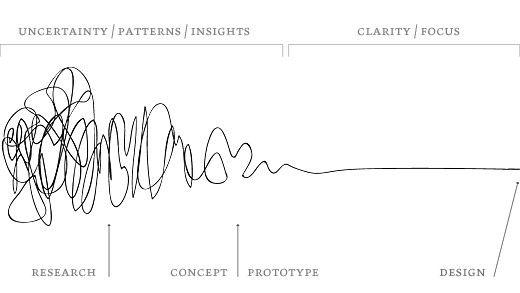- Find comfort in states of uncertainty
- Let go of being "right" and more curious about understanding the problem
- Thrive from feedback
- Share ideas without fear
Here are five things I learned along the way that can be applied to any startup if you’re interested in creating this type of culture:

In the beginning, the design thinking process feels abstract and uncomfortable since you’re wading through areas of uncertainty, but the more you can do to provide resources and in-depth explanations, the stronger your entire team will be. There can be a misconception that the process to create a valuable product is to make a list of questions or prototypes and then ask users if a feature is desirable or not. Most of the time, these tools are used more for a catalyst for conversation aimed at finding the real problem, which eventually leads to ideas about how to solve for it. Here’s another great post on that latter point. At Glassbreakers, we begin educating on the design process in the interview stage. We invite potential new employees to brainstorms and show them how our team works together when deciding to build a major new feature or take the product into a different direction. Once hired, we’ll go in depth with our design process via our assets like personas and results from the latest user experience tests, which helps us communicate the "whys" and how it relates to the user experience, engineering and/or sales.
Having the entire team involved in brainstorms, card sorting and reviews is our standard. While we all have the same mission and are aligned on the same goal — we each have different experiences that influence how we approach the product. It also uncovers different types of talents and a stronger commitment to building the best product possible. Our back-end engineers have an amazing mind for identifying edge cases. They help our design improve tremendously by looking at a mockup, thinking through how they would build it, and finding areas that need refinement on the spot.
Work modularly.
The speed and flexibility inherent in modular design enables a team to be iterative and get the most out of the design thinking process. We’ve always used a style guide that lives both online and in a Sketch file, which expedites timelines threefold. While I was building out user experience flows for a new idea last week, I pulled up the style guide and completed it quickly, since I didn’t have to create new assets or get lost in how to communicate a certain functionality since it was pre-defined. Our engineers easily throw in the appropriate class for styling instead of writing repetitive SASS. We use React classes for similar modules, which has pre-existing design as well. These tactics save a lot of time, brain-space and makes large changes never daunting since it will get implemented straight forwardly and quickly.
Find design advisors that know business.
Having advisors who have been in the trenches and understand the balance between design and business goals can help the team see things from new perspectives. I bring advisors and mentors into the conversation at least once or twice a month to review our product roadmap, analyze how we’re conducting user experience tests, goals for new features and assess overall product strategy. One of our advisors, whom has led another successful startup design from the beginning, has been critical with helping us balance our efforts towards the consumer versus enterprise product. They have been a huge influence on making design decisions that tie back to our business objectives, which keeps the team focused. After our design reviews with these leaders in the field, our team regroups and is always invigorated with new goals, ideas and measurable ways to track success.
Surround yourself with design thinkers.
It’s been important for me to be surrounded by teammates, friends and mentors that are comfortable with change, think out loud and aren’t scared of being "wrong." The community I’ve set up for myself includes people that go deep in at least one or two skillsets, but share the passion / mindset that if we want to create something, we could buckle down, learn whatever we needed to and build it. Having these peers around also inspire new ideas and ways to approach different types of design thinking that I can bring back and apply to the team at Glassbreakers.
comments powered by Disqus